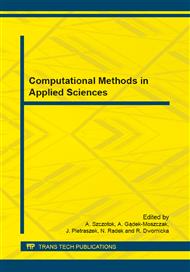[1]
J.I. Shalapko, S.G. Kostogryz, Research process of fretting-corrosion in nominal joint by modeling variation pressure, in: Proc. of Conf. Tribological Problems in Exposed Friction Systems, Bratislava, Slovak Republic, 2002, pp.292-296.
Google Scholar
[2]
J.I. Shalapko, S.G. Kostogryz, Evolution of stick-slip regime and chaos for fretting-process, in: Proc. of 8th Conf. Active noise and vibration control methods, Krasiczyn, Poland, 2007, pp.432-443.
Google Scholar
[3]
V.S. Kurskoy, J.I. Shalapko, N. Radek, Modeling of dynamical behavior of nominal-fixed joints, in: J.I. Shalapko, L.A. Dobrzański (Eds. ) Scientific basis of modern technology: experience and prospects. Gliwice, Poland, 2011, pр. 319-332.
Google Scholar
[4]
L. Radziszewski, The influence of the surface load exerted by a piezoelectric contact sensor on testing results: Part II, The electrical transients generated by piezoelectric sensor, Archives of Acoustics 28 (2003) pp.93-100.
Google Scholar
[5]
L. Radziszewski, Intrusive effect of a contact transducer on testing results, Metrology and Measurement Systems Vol. XI, 1/2004, pp.31-43.
Google Scholar
[6]
R. Ulewicz, F. Novy, J. Selejdak, Fatigue Strength of Ductile Iron in Ultra-High Cycle Regime, Advanced Materials Research 874 (2014) 43-48.
DOI: 10.4028/www.scientific.net/amr.874.43
Google Scholar
[7]
R.D. Mindlin, Elastic spheres in contact under varying oblique forces, ASME J. Appl. Mech. 75 (1953) pp.327-344.
DOI: 10.1115/1.4010702
Google Scholar
[8]
B.N.J. Persson, Sliding Friction Physical Principles and Applications, Springer, Berlin, (2000).
Google Scholar
[9]
B.S. Everitt, S. Landau, M. Leese, D. Stahl, Cluster Analysis, John Wiley & Sons, Chichester (2011).
Google Scholar
[10]
I.T. Jolliffe, Principal Component Analysis, Springer, New York (2010).
Google Scholar
[11]
E. Skrzypczak-Pietraszek, A. Hensel, Polysaccharides from Melittis melissophyllum L. herb and callus, Pharmazie 55 (2000) (10) 768-771.
Google Scholar
[12]
E. Skrzypczak-Pietraszek, J. Pietraszek, Seasonal Changes of Flavonoid Content in Melittis melissophyllum L. (Lamiaceae), Chem Biodivers 11 (2014) (4) 562-570.
DOI: 10.1002/cbdv.201300148
Google Scholar
[13]
K. Trzewiczek, A. Szczotok, A. Gądek-Moszczak, Evaluation of the State for The Material of the Live Steam Superheater Pipe Coils of V Degree, Adv Mater Res-Switz 874 (2014) 35-42.
DOI: 10.4028/www.scientific.net/amr.874.35
Google Scholar
[14]
A. Szczotok, B. Chmiela, Effect of Heat Treatment on Chemical Segregation in CMSX-4 Nickel-Base Superalloy, J Mater Eng Perform 23 (2014) 2739-2747.
DOI: 10.1007/s11665-013-0843-1
Google Scholar
[15]
J. Pietraszek, E. Skrzypczak-Pietraszek, The Optimization of the Technological Process with the Fuzzy Regression, Adv Mater Res-Switz 874 (2014) 151-155.
DOI: 10.4028/www.scientific.net/amr.874.151
Google Scholar


